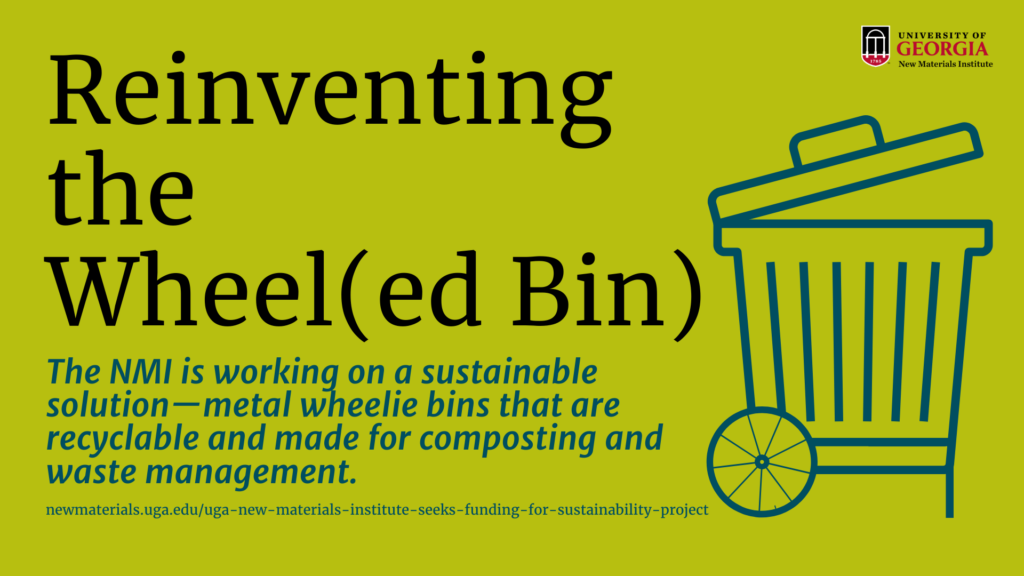UGA New Materials Institute seeks funding for sustainability project

Research from the UGA New Materials Institute found that of all plastics manufactured globally from the onset of their mass production, which followed World War II, only about 9% had been recycled. The rest were landfilled or mismanaged by being released into the environment—neither being the optimal outcome for plastic materials. Environmentally persistent plastics, which micronize as they degrade, have been found to have a profound impact on environmental, human and animal health.
Ironically, this includes plastic trash cans, or “wheeled bins”, which—granted—are manufactured ongoingly, globally, in varying sizes, for long-term use and a variety of tasks, from residential curbside pickup by solid waste management companies, to composting, to recycling, storage of animal feed, etc. According to MarketResearchFuture.com, the global market for wheeled bins manufactured from plastic, metal, or composite materials, in 2023 was valued at $6.34 billion. Plastic bins dominated the category at $3.82 billion and are expected to grow to $5 billion by 2032. Metal, valued at $1.27 billion in 2023, is expected to sustain demand and rise to $1.67 billion by 2032.
Growing household demand
Meanwhile, in the U.S.A., there is a growing household demand for wheeled bins. According to a survey of cities, towns, counties and solid waste authorities, conducted by BioCycle from February to June 2023, the number of households with access to curbside and drop-off food waste collection programs increased by 49%, from 10 million to 14.9 million, since their 2021 survey. These organic materials must be stored while awaiting curbside pickup or delivery to a local composting site. Hold that thought, while we examine some recent science.
We know that as plastics break down into smaller particles—a process called micronization—that these micro- and nanosized pieces can migrate into distant and potentially dangerous spaces in our environment, plants, animals and people. Science literature is filled with hundreds of studies, going back decades, that illustrate the potential impact of these environmentally persistent plastics on environmental, human and animal health.
Project Highlights
Prevents microplastic pollution.
Reduces landfill waste and greenhouse gases.
Supports U.S. manufacturing and a circular economy.
Micronized plastics as small as 5 nanometers
In 2018, a research team led by the UGA New Materials Institute identified micronized plastics as small as 5 nanometers inside the intestinal tracts of juvenile sea turtles—almost small enough to pass through intact tight junctions in the body (White et al., 2018). Since that study was published, we also conducted our own (unpublished) review of the science literature, searching all the way back to 1961. Here are some interesting findings from studies published since 2019:
- plants uptake micronized plastics from the soil and the particles are translocated throughout the plant and accumulate in plant tissues (Li et al., 2019);
- diet is likely a minor source of micronized plastics ingestion in pets, as these particles from food packaging bags are found in their feces (Zhang et al., 2019);
- there may be a connection between micronizing plastics, ingestion, and mortality; a study found marine mammals that died from infectious diseases had more microplastics in them than those that died from trauma or other causes of mortality (Nelms et al., 2019);
- micronized plastics (polyethylene terephthalate, or PET, and polycarbonate, or PC) exist in house dust (Zhang et al., 2020);
- plastic food packaging moderates the longitudinal association of phthalate exposure with emotional symptoms (depression, anxiety) in adolescents (Xu et al., 2021).
So how does all of this relate to the plastic trash can/wheeled bin? If you’re using it to hold solid waste destined for the landfill, then any micronized plastic from the bin would contaminate your yard and air, and any microplastics washed from your driveway or yard would eventually accumulate in our rivers, streams, lakes and oceans. If you’re using it for composting, there is the possibility that micronized plastic from the bin could contaminate the compost, which in turn could contaminate soil in which your family’s fruits, vegetables and grains are growing. There is better technology available, which won’t contaminate our environment with micronized plastics.
Evaluating composting infrastructure
Researchers from the UGA New Materials Institute have conducted several studies funded by the Walmart Foundation to evaluate curbside residential pickup and industrial composting to divert food waste and similar organic matter from landfills, where they accumulate and contribute to ground-level methane and greenhouse gases. The most recent project was conducted in Athens, Georgia in 2024.
For this project, we needed a compost container that would hold household organic waste—yard waste, eggshells, vegetable peels, table scraps, anything you can compost, liquids and all—for up to two weeks, and keep it free from interference from outdoor animals. Keeping odors down was also important. Also extremely important was how these units could be easily picked up (individually) by a hydraulic lift on a municipal solid waste truck and emptied into the truck through automated means. So, we needed something durable, easy to use and clean, that would weather well and keep animals out.
You’ll never believe what we came up with. Remember the old-style metal trash cans? Yep, except ours are smaller, are on wheels, and can be automatically “tipped” by your municipal solid waste collection truck (also known as a “tipping truck” or “tipper truck” or “dump trailer”).
Through our study, we learned how to design these metal “wheelies” for better functionality and compatibility with the automated equipment used to tip their contents into trucks. For our wheelies to reach their potential to replace wheeled bins currently manufactured from environmentally persistent micronizing plastics, we need funding, through a grant or interested industry partner, to design and manufacture the dies for a commercially viable recyclable metal wheelie.
Made in the U.S.A.
Our “wheelies” were made in the U.S.A., and we’d like to keep it that way. We worked with two specific manufacturers to produce the metal composting bins that were compatible with the automated lifting mechanisms utilized in our study. We purchased the metal cans from a Minnesota manufacturer established in 1911. We then contracted with a sheet metal fabricator located almost in our backyard, in Bogart, Georgia; they designed and made the lifting plate that served as the handlebar, and the metal can base that served as the feet and axel receiver; these installations were made on every metal trash can deployed in our project. The design work we plan to undertake will support the manufacturing of dies and tooling needed for high volume commercial production of these metal wheelies.
Our project aligns with the mission of foundations and businesses dedicated to advancing U.S. manufacturing, strengthening the U.S. steel industry, and promoting sustainability. Your support would help reduce environmental impact by replacing environmentally persistent plastic wheelies with durable, ecofriendly metal alternatives. Your support would also enhance our society, health and quality of life by:
- preventing microplastic pollution through a sustainable solution that reduces microplastic contamination, thus protecting ecosystems, animal, and human health.
- reducing landfill waste and greenhouse gases by diverting food waste from landfills, which reduces emissions and promotes large-scale composting, resulting in an end-product that enhances soil health.
- supporting U.S. manufacturing and a circular economy, thus helping to sustain and create jobs while driving the innovation of recyclable metal waste bins as an eco-friendly alternative to plastic.
If you are interested in supporting our project, please send us your contact information and include a brief statement to let us know you are interested in joining our NMI waste prevention revolution. We will be in touch. And thank you.
